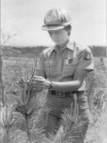Modern Foresters
Clue #1
Working Conditions for Foresters
Although some of the work is solitary, foresters and conservation scientists also deal regularly with landowners, loggers, forestry technicians and aides, farmers, ranchers, government officials, special interest groups, and the public in general. Some foresters and conservation scientists work regular hours in offices or labs. Others may split their time between field work and office work. The work can be physically demanding. Some foresters and conservation scientists work outdoors in all types of weather, sometimes in isolated areas. Other foresters may need to walk long distances through densely wooded land to carry out their work. Foresters also may work long hours fighting fires.
Tools
Foresters use a number of tools to perform their jobs. Clinometers measure the height, diameter tapes measure the diameter, and increment borers and bark gauges measure the growth of trees so that timber volumes can be computed and growth rates estimated. Photogrammetry and remote sensing (aerial photographs and other imagery taken from airplanes and satellites) often are used for mapping large forest areas and for detecting widespread trends of forest and land use. Computers are used extensively, both in the office and in the field.
(Information obtained from The Bureau of Labor Statistics, U.S. Department of Labor, Occupational Outlook Handbook, 2002-03 Edition.)
Clue #2

Forester Lea Dotson examining new growth on a pine tree. Photo from The USDA Forest Service—The First Century, Gerald W. Williams, Washington, D.C.: USDA Forest Service, July 2000.
Clue #3
The Dictionary of Forestry (Helms, John A. ed. Bethesda: Society of American Foresters, 1998) defines forestry as “ The profession embracing the science, art, and practice of creating, managing, using, and conserving forests and associated resources for human benefit and in a sustainable manner to meet desired goals, needs, and values.”
Clue #4
Quick Forestry Facts
![]() Greg Smith, former director of science and education for the Society of American Foresters (SAF) cites 5 traditional management uses of the forest:
Greg Smith, former director of science and education for the Society of American Foresters (SAF) cites 5 traditional management uses of the forest:
- timber
- water
- wildlife
- recreation
- grazing
![]() Smith also made the following declaration:
Smith also made the following declaration:
“In the past, timber received most of the attention. A few years ago, there was a shift toward considering integrated uses of the forest. …Foresters now look at managing for the whole property rather than harvesting timber at the expense of degrading other resources.”
![]() Even though modern foresters often ask scientists like botanists and biologists to help them identify and protect endangered plants and animals, they must have a strong background in science so they can understand and analyze the complex forest ecosystem.
Even though modern foresters often ask scientists like botanists and biologists to help them identify and protect endangered plants and animals, they must have a strong background in science so they can understand and analyze the complex forest ecosystem.
![]() In the past, forestry was characterized by a small number of jobs (“jack-of-all-trades”), but the profession has become quite specialized. The following are a few of the many possible careers in the forestry profession:
In the past, forestry was characterized by a small number of jobs (“jack-of-all-trades”), but the profession has become quite specialized. The following are a few of the many possible careers in the forestry profession:
- Forest hydrology
- Forest recreation and wildlife
- Forest economics
- Soil science
- Bioengineering
![]() Foresters can perform a variety of tasks, for example:
Foresters can perform a variety of tasks, for example:
- Research the various aspects of forestryConsult government or industry about forest issuesAnalyze how environment affects growth of trees and plants
- Protect forests from fires and find ways to promote growth
(The Complete Guide To Environmental Careers in the 21st Century, The Environmental Careers Organization, Island Press, Washington, D.C., 1999.)

